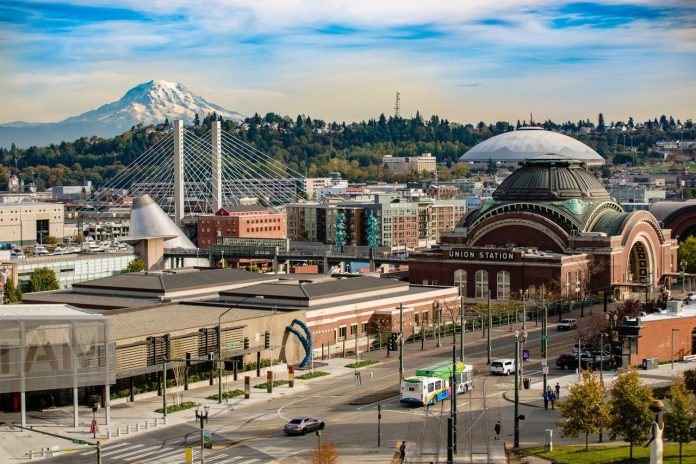
Tacoma is advancing work on what has become a multi-year process to legalize middle housing, such as fourplexes and rowhouses, throughout the city. The Home In Tacoma zoning reform process, announced back in 2020, has sought to end exclusionary zoning practices in a city mostly zoned just for single-family homes. The latest proposals offer a window into how the reform process might unfold this year as Tacoma works to complete a mandatory update to its comprehensive plan and implement new statewide housing requirements.
If fully implemented, the new framework would make many of the types of buildings that already exist in abundance in Tacoma neighborhoods like Stadium and Proctor legal again to build across the city, with expensive parking requirements in place reduced around current and planned transit.
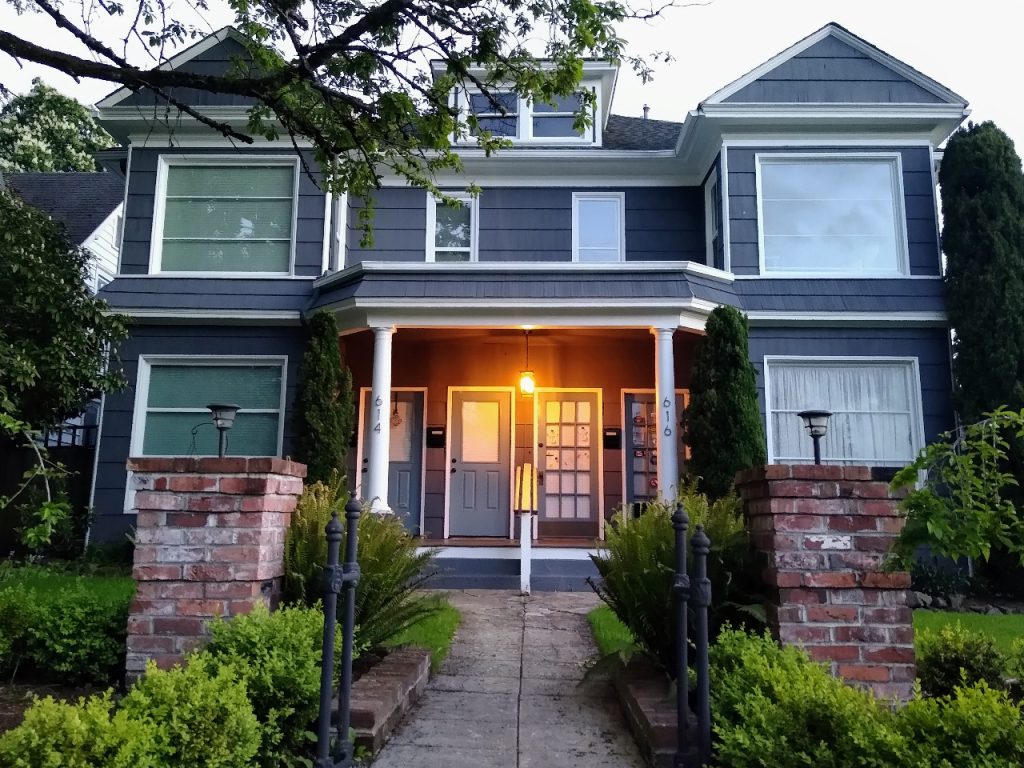
Tacoma had already began the process of phasing out single-family zoning when the Washington State Legislature passed House Bill 1110 during the 2023 session and established a statewide requirement for major cities to take that same step. As such, Tacoma has a head start on cities that are still scrambling to meet the first wave of deadlines in mid-2025.
What’s in the rezoning proposal?
Home In Tacoma is slated to bring sweeping changes to land use in the city through three new zoning types replacing single-family zones.
Two of the proposed zones (UR-1 and UR-2 zones) are at the middle housing scale and a third zone (UR-3 zone) would step up to the lowrise multifamily scale. The city is calling these Urban Residential zones with UR-1 zones being the most common type while UR-2 would generally be located within a quarter-mile of major transit stops or an eighth-mile from certain community features (e.g., parks and schools) and UR-3 zones would apply generally at the edge of commercial districts and immediately along transit corridors. As a consequence, areas west and south of Downtown Tacoma would see the highest intensity zoning changes.
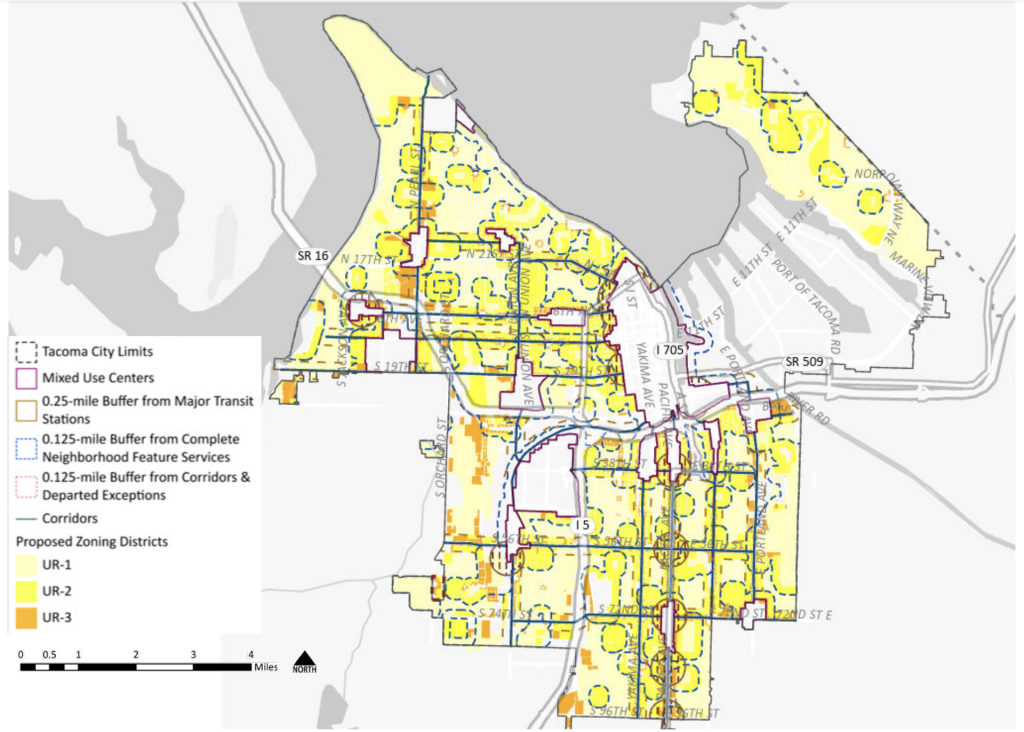
Because Tacoma is using a hard buffering approach to rezone properties, the proposed map does result in some peculiar outcomes on blocks. Consistent zoning changes often don’t cover a full block face, leaving some lots at midblock or on corners with completely different zoning than the prevailing zoning proposed on block faces. If this is maintained, it will certainly create an atypical hodgepodge of zoning on blocks throughout the city and could reduce development potential in some cases.
Tacoma’s planners tested variations of rezoning intensities to ascertain the likely level of new development capacity and homes that would be built through 2050 and included their findings in the Draft Environmental Impact Statement (DEIS). The zoning proposal is essentially a hybrid of the two action alternatives studied in the DEIS, which portends significant increases in potential development capacity (somewhere between 334,705 and 700,734 net new homes) and realized homebuilding (somewhere between 25,660 and 53,620 net new homes).
Along with the zoning changes, Tacoma would expand reduced parking areas to comply with House Bill 1110, which preempts car parking mandates within a half-mile walking distance of major transit stops. Full parking exemptions, as contemplated in the proposal, would generally apply along Pacific Avenue/SR 7, 6th Avenue, and S 19th Street where high-capacity transit is planned. Outside of those areas, Tacoma would also make changes to car parking mandates by adjusting them downward to meet HB 1110 requirements and achieve other objectives of Home In Tacoma.
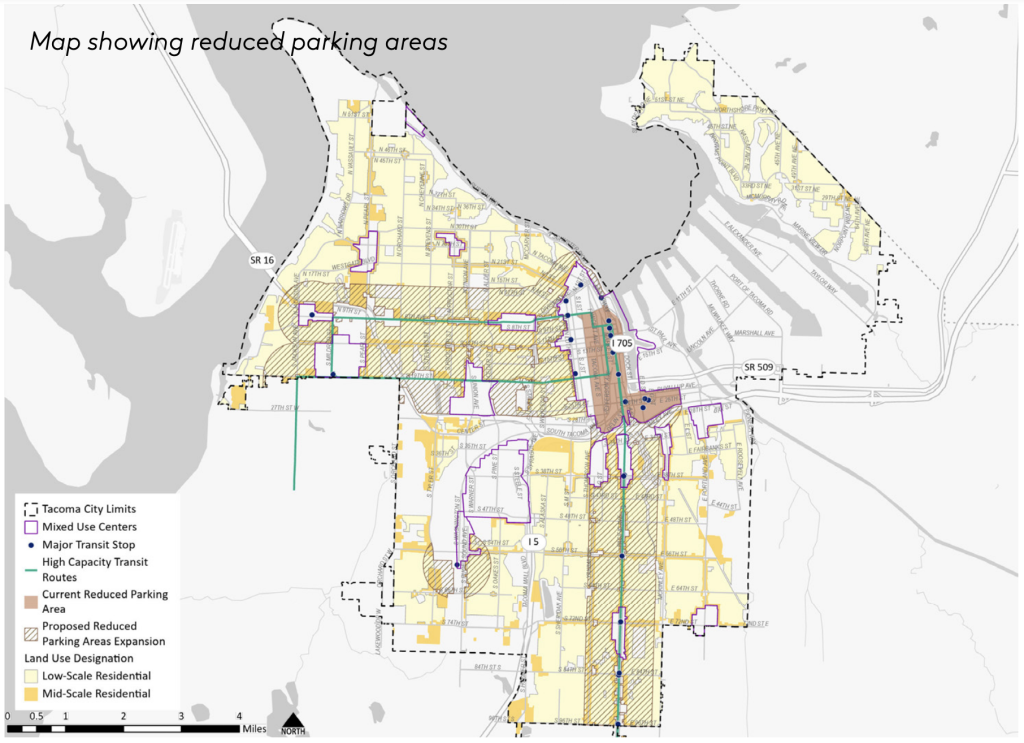
The new zoning would allow a broad spectrum of housing types that Tacoma is redefining through the Home In Tacoma initiative. All three zoning types would allow “houseplex” uses, which the city considers to be a single building with one to six dwelling units and similar in size to typical a detached single-family house.
“Backyard buildings,” “courtyard housing,” and “rowhouses” would also be allowed in all three zones. As contemplated in the initiative, backyard buildings are residential structures located at the rear of a lot, courtyard housing is attached (only in UR-2 and UR-3 zones) or detached (all three zones) units which are oriented around a central common space, and rowhouses are buildings with three to six attached units sharing side walls. Finally, “multiplex” uses would have seven or more stacked units and only be allowed in UR-3 zones.
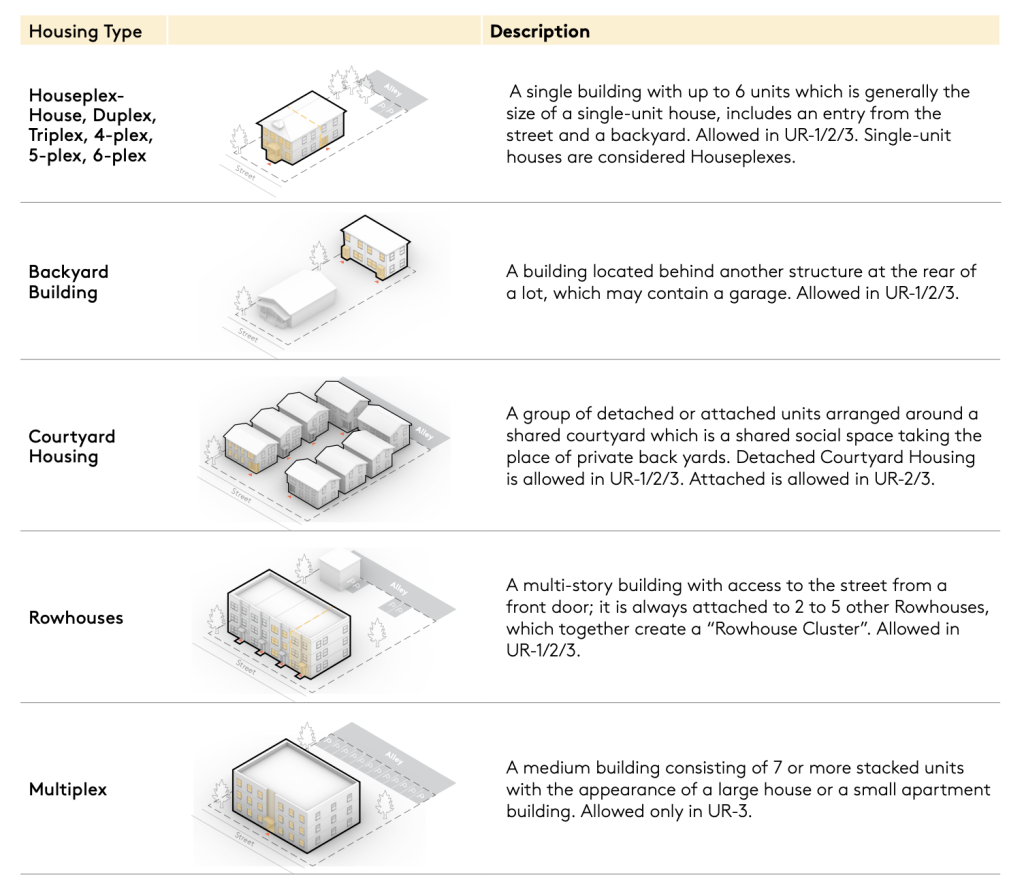
Development standards for zones, however, would still determine the number of dwelling units allowed on a lot. In the least dense zone, typical lots with UR-1 zoning would only be able to achieve four dwelling units without use of density of bonuses.
In broad strokes, the zoning type development standards would differ as follows:
| Standard | UR-1 Zone | UR-2 Zone | UR-3 Zone |
|---|---|---|---|
| Allowed Uses1 | Houseplexes, backyard buildings, rowhouses, and courtyard housing (detached) | Houseplexes, backyard buildings, rowhouses, and courtyard housing (detached and attached) | Houseplexes, backyard buildings, rowhouses, courtyard housing (detached and attached), multiplexes |
| Density Limit2 | Base: 4 units per lot Bonus 1: 6 units per lot Bonus 2: 8 units per lot | Base: 6 units per lot Bonus 1: 8 units per lot Bonus 2: 12 units per lot | Base: 8 units per lot Bonus 1: 12 units per lot Bonus 2: 16 units per lot |
| FAR Limit | Base: 0.6 for 1 to 2 units and 0.8 for 3 or more units Bonus 1: 1.0 Bonus 2: 1.2 | Base: 0.8 for 1 to 2 units and 1.0 for 3 or more units Bonus 1: 1.2 Bonus 2: 1.6 | Base: 1.0 for 1 to 2 units and 1.2 for 3 or more units Bonus 1: 1.6 Bonus 2: 2.0 |
| Height Limit | Base: 35 feet, except 25 feet in rear 25 feet of lot Bonus 1: same Bonus 2: same | Base: 35 feet, except 25 feet in rear 25 feet of lot Bonus 1: same Bonus 2: same | Base: 35 feet Bonus 1: 45 feet (4 stories) Bonus 2: 45 feet (5 stories) |
| Setbacks (Front and Rear) | Base: 15 feet Bonus 1: 10 feet Bonus 2: 5 feet | Base: 15 feet Bonus 1: 10 feet Bonus 2: 5 feet | Base: 10 feet Bonus 1: 7.5 feet Bonus 2: 5 feet |
| Minimum Car Parking Mandates3 | Base: 1 stall per unit Bonus 1: none for bonus units Bonus 2: none | Base: 0.75 stalls per unit Bonus 1: none for bonus units Bonus 2: none | Base: 0.5 stalls per unit Bonus 1: none for bonus units Bonus 2: none |
| Required Amenity Space | Base: 300 square feet per unit Bonus 1: 250 square feet per unit Bonus 2: 200 square feet per unit | Base: 200 square feet per unit Bonus 1: 150 square feet per unit Bonus 2: 100 square feet per unit | Base: 100 square feet per unit Bonus 1: 75 square feet per unit Bonus 2: 50 square feet per unit |
| Tree Credits (Canopy Equivalent)4 | Base: 35% Bonus 1: 30% Bonus 2: 25% | Base: 30% Bonus 1: 25% Bonus 2: 20% | Base: 25% Bonus 1: 20% Bonus 2: 15% |
| Bonuses5 | Bonus 1: 2 units or 20% of total units made moderately affordable (80% AMI for rental, 100% for ownership) for 50 years, $62,000 in lieu fee payment per unit, or retention of principal building and addition of at least one unit Bonus 2: All units made deeper affordable (60% AMI for rental, 80% AMI for ownership) for 50 years | Bonus 1: 2 units or 20% of total units made moderately affordable (80% AMI for rental, 100% for ownership) for 50 years, $62,000 in lieu fee payment per unit, or retention of principal building and addition of at least one unit Bonus 2: All units made deeper affordable (60% AMI for rental, 80% AMI for ownership) for 50 years | Bonus 1: 20% of total units made moderately affordable (70% AMI for rental, 100% for ownership) for 50 years, $72,000 in lieu fee payment per unit, or retention of principal building and addition of at least one unit Bonus 2: All units made deeper affordable (60% AMI for rental, 80% AMI for ownership) for 50 years |
2. Based upon a 6,000 square foot lot. Also, pre-existing lots that are smaller would be permitted to built at least 4 unit and 2 additional bonus units.
3. No parking in reduced parking areas, including within a half-mile walking distance of major transit stops.
4. Where planting is infeasible, an in lieu fee payment made be made.
5. The Multi-Family Tax Exemption program would be expanded to cover all UR-3 zones and could be used by developers providing affordable housing units.
In addition to the development standards noted in the table, Tacoma has developed design standards specific to the different housing types. These generally deal with things like building placement, pedestrian and parking access, building size, building articulation, and open space.
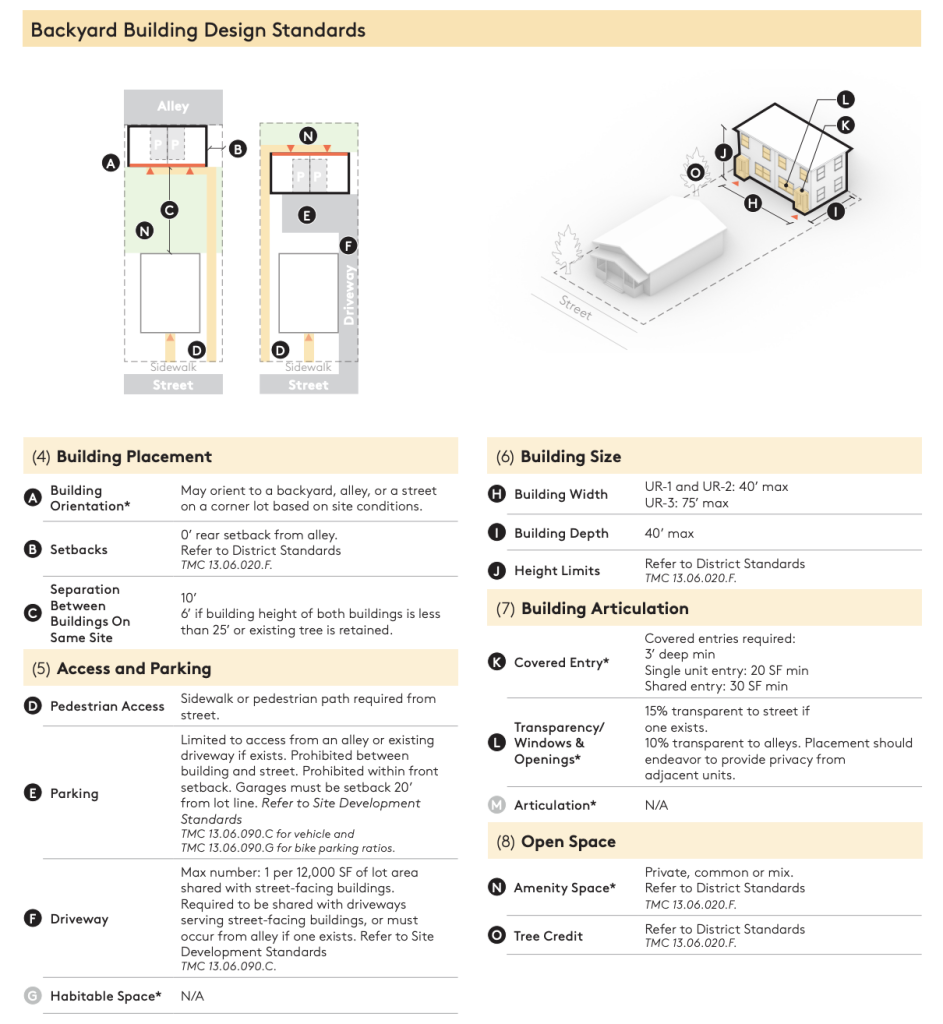
Home In Tacoma has taken longer than anticipated
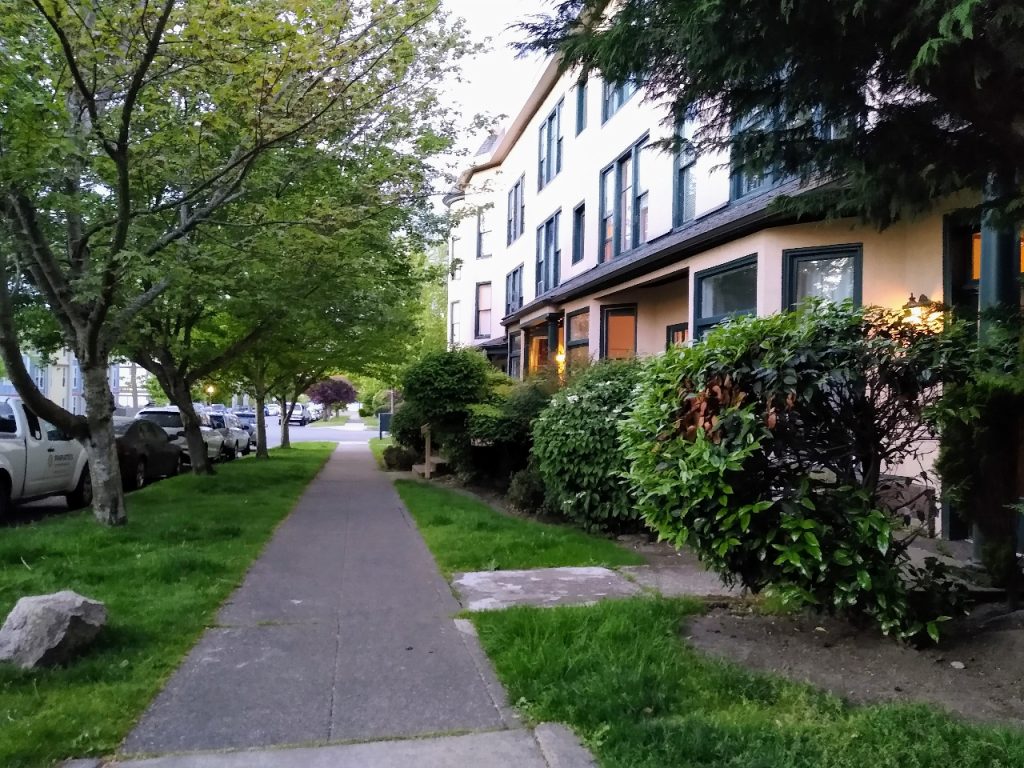
As a process, Home In Tacoma has taken a lot longer to implement than originally envisioned. A year and a half transpired between a scoping report to the first major deliverable in late 2021: an update to the city’s comprehensive plan and limited zoning code changes. As part of that, the Tacoma City Council pared back some of the proposed reforms. Following completion of the first phase of the initiative, the City had planned to proceed with development of formal zoning and land use code changes with an eye toward adoption sometime in 2023.
However, the process was slowed a bit with the passage of HB 1110 mandating cities allow middle housing and HB 1337 requiring cities to permit up to two accessory dwelling units per lot and modify other development standards since the laws affected some aspects of the Home In Tacoma initiative, necessitating adjustments to harmonize the initiative with the new laws.
If all goes according to plan, Home In Tacoma could finally wrap up in the summertime with city council approval. But for now, the new proposal is headed for a planning commission hearing on Wednesday, March 6 at 5:30pm at Tacoma City Hall. A public comment period on the proposal will also remain open through March 8.
Stephen is a professional urban planner in Puget Sound with a passion for sustainable, livable, and diverse cities. He is especially interested in how policies, regulations, and programs can promote positive outcomes for communities. With stints in great cities like Bellingham and Cork, Stephen currently lives in Seattle. He primarily covers land use and transportation issues and has been with The Urbanist since 2014.

